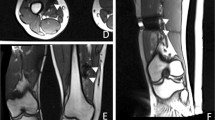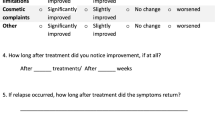Abstract
Purpose
To report the mid-term outcomes of percutaneous cryoablation (PCA) performed as second-line therapeutic option of venous malformations (VM).
Material and methods
From 2011 to 2015, PCA was offered in 24 patients (mean age: 31 years, range: 12–64) as second-line treatment for recurrence of symptoms after sclerotherapy and when resection was not possible (due to lesion location or previous failure) or refused by the patient. Adverse effects were recorded, disease-free survival (DFS) and local tissue control (LTC) rates were calculated based on symptoms and volume evolution.
Results
Mean follow-up was 18.7 months (6–48). Nine (37.5%, 9/24) adverse effects occurred and three (12.5%, 3/24) were severe. Mean pain assessed by visual analog scale (VAS) was 41.7 mm (0–80) before treatment and 20.3 mm (0–80) (p=0.01) after. Mean volume decreased significantly after treatment from 22.4 cm3 (0.9-146) to 8.35 cm3 (0–81.3) (p<0.001). Pain recurred in nine patients and size of one lesion increased. The DFS and LTC rates were 54% [95%CI: 22.94-77.27] and 93.33% [61.26-99.03] at 24 months, respectively. Only VM volume >10 cm3 was associated with a higher risk of local recurrence (p=0.05).
Conclusion
PCA as second-line treatment appears to be safe and effective for local control of VM according to mid-term results.
Key points
• Percutaneous cryoablation of venous malformations appeared well tolerated.
• Size of venous malformations decreased significantly after percutaneous cryoablation (p<0.001).
• Pain decreased significantly after percutaneous cryoablation of venous malformations (p=0.01).





Similar content being viewed by others
References
Mulliken JB (1993) Cutaneous vascular anomalies. Semin Vasc Surg 6:204–218
Redondo P, Aguado L, Martinez-Cuesta A (2011) Diagnosis and management of extensive vascular malformations of the lower limb: part II. systemic repercussions [corrected], diagnosis, and treatment. J Am Acad Dermatol 65:909–923, quiz 924
Redondo P, Aguado L, Martinez-Cuesta A (2011) Diagnosis and management of extensive vascular malformations of the lower limb: part I. clinical diagnosis. J Am Acad Dermatol 65:893–898
Kim YW (2010) Proper selection of patients for percutaneous embolo-sclerotherapy in patients with congenital vascular malformations (CVMs). Eur J Vasc Endovasc Surg 39:S49–S54
James CA, Braswell LE, Wright LB et al (2011) Preoperative sclerotherapy of facial venous malformations: impact on surgical parameters and long-term follow-up. J Vasc Interv Radiol 22:953–960
Hyodoh H, Hori M, Akiba H et al (2005) Peripheral vascular malformations: imaging, treatment approaches, and therapeutic issues. Radiographics 25:S159–S171
Childs DD, Emory CL (2012) Successful treatment of intramuscular venous malformation with image-guided radiofrequency ablation. J Vasc Interv Radiol 23:1391–1393
van der Linden E, Overbosch J, Kroft LJ (2005) Radiofrequency ablation for treatment of symptomatic low-flow vascular malformations after previous unsuccessful therapy. J Vasc Interv Radiol 16:747–750
Garg S, Kumar S, Singh YB (2015) Intralesional radiofrequency in venous malformations. Br J Oral Maxillofac Surg 53:213–216
Thompson SM, Callstrom MR, McKusick MA, Woodrum DA (2015) Initial results of image-guided percutaneous ablation as second-line treatment for symptomatic vascular anomalies. Cardiovasc Interv Radiol 38:1171–1178
van Breugel JM, Nijenhuis RJ, Ries MG et al (2015) Non-invasive magnetic resonance-guided high intensity focused ultrasound ablation of a vascular malformation in the lower extremity: a case report. J Ther Ultrasound 3:23
Cornelis F, Havez M, Labrèze C et al (2013) Percutaneous cryoablation of symptomatic localized venous malformations: preliminary short-term results. J Vasc Interv Radiol 24:823–827
Cornelis F, Neuville A, Labreze C et al (2013) Percutaneous cryotherapy of vascular malformation: initial experience. Cardiovasc Interv Radiol 36:853–856
Shaikh R, Alomari AI, Kerr CL, et al. (2016) Cryoablation in fibro-adipose vascular anomaly (FAVA): a minimally invasive treatment option. Pediatr Radiol
Cornelis FH, Labrèze C, Pinsolle V, et al. (2017) Percutaneous image-guided cryoablation as second-line therapy of soft-tissue venous vascular malformations of extremities: a prospective study of safety and 6-month efficacy. Cardiovasc Intervent Radiol
Atwell TD, Farrell MA, Leibovich BC et al (2008) Percutaneous renal cryoablation: experience treating 115 tumors. J Urol 179:2131–2136
Kunkle DA, Uzzo RG (2008) Cryoablation or radiofrequency ablation of the small renal mass : a meta-analysis. Cancer 113:2671–2680
Habash RW, Bansal R, Krewski D, Alhafid HT (2007) Thermal therapy, Part III: ablation techniques. Crit Rev Biomed Eng 35:37–121
Solomon SB, Silverman SG (2010) Imaging in interventional oncology. Radiology 257:624–640
Havez M, Lippa N, Al-Ammari S et al (2014) Percutaneous image-guided cryoablation in inoperable extra-abdominal desmoid tumors: a study of tolerability and efficacy. Cardiovasc Interv Radiol 37:1500–1506
Kujak JL, Liu PT, Johnson GB, Callstrom MR (2010) Early experience with percutaneous cryoablation of extra-abdominal desmoid tumors. Skeletal Radiol 39:175–182
Weld KJ, Landman J (2005) Comparison of cryoablation, radiofrequency ablation and high-intensity focused ultrasound for treating small renal tumours. BJU Int 96:1224–1229
Cornelis F, Havez M, Lippa N et al (2013) Radiologically guided percutaneous cryotherapy for soft tissue tumours: a promising treatment. Diagn Interv Imaging 94:364–370
Tuncali K, Morrison PR, Winalski CS et al (2007) MRI-guided percutaneous cryotherapy for soft-tissue and bone metastases: initial experience. AJR Am J Roentgenol 189:232–239
Beland MD, Wasser EJ, Mayo-Smith WW, Dupuy DE (2010) Primary non-small cell lung cancer: review of frequency, location, and time of recurrence after radiofrequency ablation. Radiology 254:301–307
Walder HA (1971) Application of cryotherapy in cerebrovascular anomalies: an experimental and clinical study. J Neurol Neurosurg Psychiatry 34:105
Yakes WF (2004) Endovascular management of high-flow arteriovenous malformations. Semin Intervent Radiol 21:49–58
Yakes WF (2015) Use of multiple sclerosant agents in vascular malformation management: a world in endovascular confusion and chaos. J Vasc Interv Radiol 26:1494–1496
Goldberg SN, Grassi CJ, Cardella JF et al (2005) Image-guided tumor ablation: standardization of terminology and reporting criteria. J Vasc Interv Radiol 16:S377–S390
Hjermstad MJ, Fayers PM, Bjordal K, Kaasa S (1998) Using reference data on quality of life--the importance of adjusting for age and gender, exemplified by the EORTC QLQ-C30 (+3). Eur J Cancer 34:1381–1389
Sala F, Niimi Y, Berenstein A, Deletis V (2000) Role of multimodality intraoperative neurophysiological monitoring during embolisation of a spinal cord arteriovenous malformation. Interv Neuroradiol 6:223–234
van der Vleuten CJ, Kater A, Wijnen MH et al (2014) Effectiveness of sclerotherapy, surgery, and laser therapy in patients with venous malformations: a systematic review. Cardiovasc Interv Radiol 37:977–989
Behravesh S, Yakes W, Gupta N, et al. (2016) Venous malformations: clinical diagnosis and treatment. Cardiovasc Diagn Ther 6:557–569. doi: 10.21037/cdt.2016.11.10
McCafferty I (2015) Management of low-flow vascular malformations: clinical presentation, classification, patient selection, imaging and treatment. Cardiovasc Intervent Radiol 38:1082–1104
Lee BB, Do YS, Byun HS et al (2003) Advanced management of venous malformation with ethanol sclerotherapy: mid-term results. J Vasc Surg 37:533–538
Breugem CC, Maas M, Reekers JA, van der Horst CM (2001) Use of magnetic resonance imaging for the evaluation of vascular malformations of the lower extremity. Plast Reconstr Surg 108:870–877
Breugem CC, Maas M, van der Horst CM (2001) Magnetic resonance imaging findings of vascular malformations of the lower extremity. Plast Reconstr Surg 108:878–884
Moukaddam H, Pollak J, Haims AH (2009) MRI characteristics and classification of peripheral vascular malformations and tumors. Skelet Radiol 38:535–547
Gokani VJ, Kangesu L, Harper J, Sebire NJ (2011) Venous malformation associated nerve profiles and pain: an immunohistochemical study. J Plast Reconstr Aesthet Surg 64:439–444
Maillot J, Brun JL, Dubuisson V et al (2017) Mid-term outcomes after percutaneous cryoablation of symptomatic abdominal wall endometriosis: comparison with surgery alone in a single institution. Eur Radiol. doi:10.1007/s00330-017-4827-7
Acknowledgements
The authors thank Pippa McKelvie-Sebileau for medical editorial services, Corinne Castermans for her assistance with data collection and Pascal Garcia, PhD for his technical support.
Author information
Authors and Affiliations
Corresponding author
Ethics declarations
Guarantor
The scientific guarantor of this publication is Francois CORNELIS.
Conflict of interest
The authors of this manuscript declare no relationships with any companies, whose products or services may be related to the subject matter of the article.
Funding
CHU Bordeaux provided partial funding (Grant No. NCT01845935). F.C. received research support from Galil Medical Inc., Arden Hills, MN, USA.
Statistics and biometry
No complex statistical methods were necessary for this paper.
Informed consent
Written informed consent was waived by the Institutional Review Board.
Ethical approval
Institutional Review Board approval was obtained.
Study subjects or cohorts overlap
Some study subjects or cohorts have been previously reported in "Cornelis F, Havez M, Labrèze C, Taieb A, Bui BN, Midy D, Grenier N. Percutaneous cryoablation of symptomatic localized venous malformations: preliminary short-term results. J Vasc Interv Radiol. 2013 Jun;24(6):823–7." and in "Cornelis FH, Labrèze C, Pinsolle V, Le Bras Y, Castermans C, Bader C, Thiebaut R, Midy D, Grenier N. Percutaneous Image-Guided Cryoablation as Second-Line Therapy of Soft-Tissue Venous Vascular Malformations of Extremities: A Prospective Study of Safety and 6-Month Efficacy. Cardiovasc Intervent Radiol. 2017 Mar 30. [Epub ahead of print] "
Methodology
• retrospective
• observational
• performed at one institution
Rights and permissions
About this article
Cite this article
Cornelis, F.H., Marin, F., Labrèze, C. et al. Percutaneous cryoablation of symptomatic venous malformations as a second-line therapeutic option: a five-year single institution experience. Eur Radiol 27, 5015–5023 (2017). https://doi.org/10.1007/s00330-017-4892-y
Received:
Revised:
Accepted:
Published:
Issue Date:
DOI: https://doi.org/10.1007/s00330-017-4892-y




